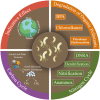Microorganisms in coastal wetland sediments: a review on microbial community structure, functional gene, and environmental potential
- PMID: 37333635
- PMCID: PMC10272453
- DOI: 10.3389/fmicb.2023.1163896
Microorganisms in coastal wetland sediments: a review on microbial community structure, functional gene, and environmental potential
Abstract
Coastal wetlands (CW) are the junction of the terrestrial and marine ecosystems and have special ecological compositions and functions, which are important for maintaining biogeochemical cycles. Microorganisms inhabiting in sediments play key roles in the material cycle of CW. Due to the variable environment of CW and the fact that most CW are affected by human activities and climate change, CW are severely degraded. In-depth understanding of the community structure, function, and environmental potential of microorganisms in CW sediments is essential for wetland restoration and function enhancement. Therefore, this paper summarizes microbial community structure and its influencing factors, discusses the change patterns of microbial functional genes, reveals the potential environmental functions of microorganisms, and further proposes future prospects about CW studies. These results provide some important references for promoting the application of microorganisms in material cycling and pollution remediation of CW.
Keywords: coastal wetlands; community structure; environmental potential; functional gene; microorganisms.
Copyright © 2023 Liang, Li, Wu, Yan and Song.
Conflict of interest statement
The authors declare that the research was conducted in the absence of any commercial or financial relationships that could be construed as a potential conflict of interest.
Figures




Similar articles
-
Influence of plants and environmental variables on the diversity of soil microbial communities in the Yellow River Delta Wetland, China.Chemosphere. 2021 Jul;274:129967. doi: 10.1016/j.chemosphere.2021.129967. Epub 2021 Feb 15. Chemosphere. 2021. PMID: 33979943
-
[Impacts of Spartina alterniflora invasion on coastal wetland ecosystem: Advances and prospects].Ying Yong Sheng Tai Xue Bao. 2020 Jun;31(6):2119-2128. doi: 10.13287/j.1001-9332.202006.032. Ying Yong Sheng Tai Xue Bao. 2020. PMID: 34494766 Review. Chinese.
-
Response of microbial community to different media in start-up period of Annan constructed wetland in Beijing of China.Environ Pollut. 2023 Nov 15;337:122529. doi: 10.1016/j.envpol.2023.122529. Epub 2023 Sep 8. Environ Pollut. 2023. PMID: 37690468 Review.
-
Spatiotemporal shifts of ammonia-oxidizing archaea abundance and structure during the restoration of a multiple pond and plant-bed/ditch wetland.Sci Total Environ. 2019 Sep 20;684:629-640. doi: 10.1016/j.scitotenv.2019.04.415. Epub 2019 May 27. Sci Total Environ. 2019. PMID: 31170597
-
Soil microbial community development across a 32-year coastal wetland restoration time series and the relative importance of environmental factors.Sci Total Environ. 2022 May 15;821:153359. doi: 10.1016/j.scitotenv.2022.153359. Epub 2022 Jan 23. Sci Total Environ. 2022. PMID: 35081409
Cited by
-
Vegetation-Driven Changes in Soil Salinity Ions and Microbial Communities Across Tidal Flat Reclamation.Microorganisms. 2025 May 22;13(6):1184. doi: 10.3390/microorganisms13061184. Microorganisms. 2025. PMID: 40572072 Free PMC article.
-
Seasonality and Vertical Structure of Microbial Communities in Alpine Wetlands.Microorganisms. 2025 Apr 23;13(5):962. doi: 10.3390/microorganisms13050962. Microorganisms. 2025. PMID: 40431136 Free PMC article.
-
Editorial: Microbial ecological and biogeochemical processes in the soil-vadose zone-groundwater habitats, volume II.Front Microbiol. 2024 Sep 9;15:1486331. doi: 10.3389/fmicb.2024.1486331. eCollection 2024. Front Microbiol. 2024. PMID: 39314873 Free PMC article. No abstract available.
-
A culture-independent approach, supervised machine learning, and the characterization of the microbial community composition of coastal areas across the Bay of Bengal and the Arabian Sea.BMC Microbiol. 2024 May 10;24(1):162. doi: 10.1186/s12866-024-03295-4. BMC Microbiol. 2024. PMID: 38730339 Free PMC article.
-
Exploring the antibacterial potential of environmental Pseudomonas aeruginosa isolates: Insights from in vitro studies and genome mining approaches.J Genet Eng Biotechnol. 2025 Sep;23(3):100508. doi: 10.1016/j.jgeb.2025.100508. Epub 2025 May 17. J Genet Eng Biotechnol. 2025. PMID: 40854628 Free PMC article.
References
-
- Abdu N., Abdullahi A. A., Abdulkadir A. (2017). Heavy metals and soil microbes. Environ. Chem. Lett. 15, 65–84. doi: 10.1007/s10311-016-0587-x - DOI
-
- Adame M. F., Reef R., Herrera-Silveira J. A., Lovelock C. E. (2012). Sensitivity of dissolved organic carbon exchange and sediment bacteria to water quality in mangrove forests. Hydrobiologia 691, 239–253. doi: 10.1007/s10750-012-1071-7 - DOI
-
- An J., Liu C., Wang Q., Yao M., Rui J., Zhang S., et al. . (2019). Soil bacterial community structure in Chinese wetlands. Geoderma 337, 290–299. doi: 10.1016/j.geoderma.2018.09.035 - DOI
Publication types
LinkOut - more resources
Full Text Sources

